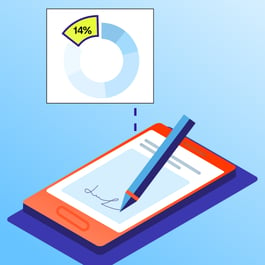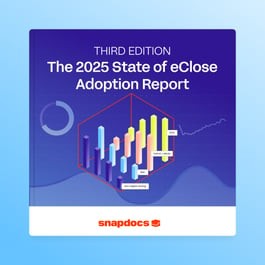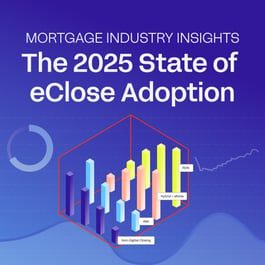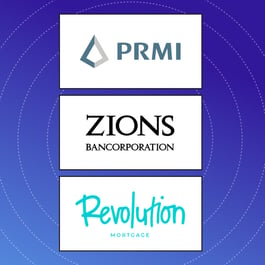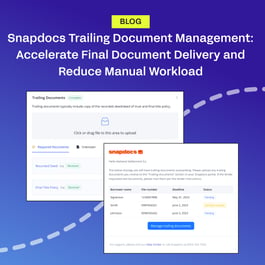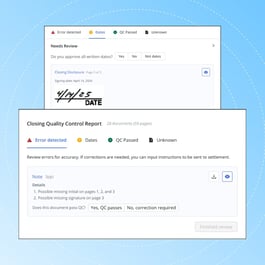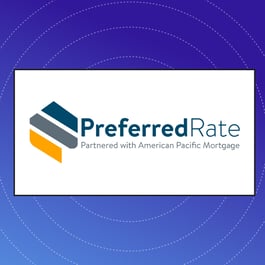This article is part of our educational series on the five key factors that determine how digital your mortgage closings can be, known as e-Eligibility. For more information, download the full eBook or get your free e-Eligibility assessment to determine how digitized each loan in your portfolio can be.
Today’s borrowers expect speed, convenience, and flexibility from their lenders. Finastra’s 2021 article “Three reasons the mortgage industry is embracing eClosing” proved that as much as 81% of consumers now prefer a digital experience. 2020 revealed a major shift in borrower habits, as indicated by the 250% increase in the number of electronic promissory notes (eNotes) registered on the MERS® eRegistry compared to 2019.
With this top of mind, Snapdocs released an educational series on the five key factors that determine how digital your mortgage closings can be, known as e-Eligibility.
Digitizing mortgage closings comes with its own set of challenges, however. Among them, lenders must account for the five R’s of e-Eligibility, or the factors that impact the extent to which a mortgage can be closed digitally. One of the factors is eNotarization regulations which is the main topic of this piece.
The “regulations” refer to whether the state laws and regulations permit the use of eNotarization, generally in-person electronic notarization (IPEN) or remote online notarization (RON). IPEN is the act of conducting eNotarizations in person, while RON eliminates the need to meet in person. With RON, the notary and signer meet virtually using a platform that enables two-way audiovisual technology, similar to a webcam, to conduct an eNotarization.
In addition to legal and regulatory enablement by states, state agencies might impose requirements that eNotarization platforms be approved to facilitate eNotarizations in that state.
The chart below gives lenders a detailed framework for what to consider when assessing eNote regulations.
eNotarization Regulations at a Glance
Definition of eNotarization Regulations:
- Whether the state permits the use of eNotarization
Primary Stakeholders:
- States, notaries
Objects:
- Closing documents that require notarization
Systems:
- RON platforms, IPEN platforms
Mortgage Cycle:
- Typically at closing, and during the in-person or remote closing appointment, as applicable
Decision Power:
- None-state laws dictate whether and what types of eNotarization are permissible in that state
Boons:
- ++ The state permits both forms of eNotarization (IPEN and RON) + The state permits at least one form of eNotarization (IPEN or RON)
- + The state permits (or does not prohibit) out-of-state RON
Drags:
- The state does not permit IPEN
- The state does not permit RON
- The state does not permit IPEN or RON
Sources of Variability:
- State-specific eNotarization requirements, eNotarization platform, eNotary-specific requirements/certifications
Process:
- The notary attends the closing appointment, verifies the borrower’s identity, and applies his/her signature and notarial seal to the closing document.
- For Wet Closings, or closings with IPEN, the notary and borrower are co-located and the notarization occurs at an in-person closing appointment. For closings with RON, the notary and borrower are not co-located. Instead, the borrower and notary meet virtually and the notarial act is carried out through a live audio-video feed, similar to a webcam.
For Wet Closings, the notary uses traditional wet-ink and seal to notarize the paper document. For Hybrid or Full eClosings facilitated by IPEN or RON, the notary electronically notarizes the document.
Considerations:
- With respect to eNotarization, the primary consideration is whether the state permits IPEN and/or RON. Otherwise, the use of eSignatures is enabled in all 50 states through a combination of federal and state laws. Also, some states require that the eNotarization platform be approved for eNotarizations in that state.
- The complexity and ambiguity of e-Eligibility are causing many lenders to default to suboptimal closing methodologies. We’re here to help. Lenders can optimize their mortgage closings with a framework for the digitization process.













